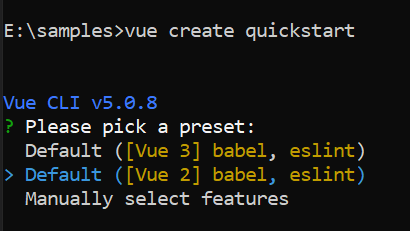Getting Started with the Vue Daterangepicker Component in Vue 2
25 Apr 20259 minutes to read
This article provides a step-by-step guide for setting up a Vue 2 project using Vue-CLI and integrating the Syncfusion® Vue Daterangepicker component using the Composition API / Options API.
Prerequisites
System requirements for Syncfusion® Vue UI components
Dependencies
The list of dependencies required to use the DateRangePicker component in your application is given below:
|-- @syncfusion/ej2-vue-calendars
|-- @syncfusion/ej2-base
|-- @syncfusion/ej2-data
|-- @syncfusion/ej2-vue-base
|-- @syncfusion/ej2-calendars
|-- @syncfusion/ej2-inputs
|-- @syncfusion/ej2-splitbuttons
|-- @syncfusion/ej2-lists
|-- @syncfusion/ej2-popups
|-- @syncfusion/ej2-buttonsSetting up the Vue 2 project
To generate a Vue 2 project using Vue-CLI, use the vue create command. Follow these steps to install Vue CLI and create a new project:
npm install -g @vue/cli
vue create quickstart
cd quickstart
npm run serveor
yarn global add @vue/cli
vue create quickstart
cd quickstart
yarn run serveWhen creating a new project, choose the option Default ([Vue 2] babel, eslint) from the menu.

Once the quickstart project is set up with default settings, proceed to add Syncfusion® components to the project.
Add Syncfusion® Vue packages
Syncfusion® packages are available at npmjs.com. To use Vue components, install the required npm package.
This article uses the Vue Daterangepicker component as an example. Install the @syncfusion/ej2-vue-calendars package by running the following command:
npm install @syncfusion/ej2-vue-calendars --saveor
yarn add @syncfusion/ej2-vue-calendarsImport Syncfusion® CSS styles
You can import themes for the Syncfusion® Vue component in various ways, such as using CSS or SASS styles from npm packages, CDN, CRG and Theme Studio. Refer to themes topic to know more about built-in themes and different ways to refer to themes in a Vue project.
In this article, the Material theme is applied using CSS styles, which are available in installed packages. The necessary Material CSS styles for the Daterange component and its dependents were imported into the <style> section of src/App.vue file.
<style>
@import '../node_modules/@syncfusion/ej2-base/styles/material.css';
@import '../node_modules/@syncfusion/ej2-buttons/styles/material.css';
@import '../node_modules/@syncfusion/ej2-inputs/styles/material.css';
@import '../node_modules/@syncfusion/ej2-popups/styles/material.css';
@import '../node_modules/@syncfusion/ej2-lists/styles/material.css';
@import "../node_modules/@syncfusion/ej2-vue-calendars/styles/material.css";
</style>Note: If you want to refer the combined component styles, please make use of our
CRG(Custom Resource Generator) in your application.
Add Syncfusion® Vue component
Follow the below steps to add the Vue Daterangepicker component using Composition API or Options API:
1. First, import and register the Daterangepicker component in the script section of the src/App.vue file. If you are using the Composition API, you should add the setup attribute to the script tag to indicate that Vue will be using the Composition API.
<script>
import { DateRangePickerComponent as EjsDaterangepicker } from '@syncfusion/ej2-vue-calendars';
</script><script>
import { DateRangePickerComponent } from '@syncfusion/ej2-vue-calendars';
export default {
components: {
'ejs-daterangepicker': DateRangePickerComponent
}
}
</script>2. In the template section, define the Daterangepicker component with the placeholder property.
<template>
<div id="app">
<div class='wrapper'>
<ejs-daterangepicker :placeholder="waterMark"></ejs-daterangepicker>
</div>
</div>
</template>3. Declare the value for the placeholder property in the script section.
<script setup>
const waterMark = 'Select a Range';
</script><script>
data () {
return {
waterMark : 'Select a Range'
}
}
</script>Here is the summarized code for the above steps in the src/App.vue file:
<template>
<div id="app">
<div class='wrapper'>
<ejs-daterangepicker :placeholder="waterMark"></ejs-daterangepicker>
</div>
</div>
</template>
<script setup>
import { DateRangePickerComponent as EjsDaterangepicker } from '@syncfusion/ej2-vue-calendars';
const waterMark = 'Select a Range';
</script>
<style>
@import '../node_modules/@syncfusion/ej2-base/styles/material.css';
@import '../node_modules/@syncfusion/ej2-buttons/styles/material.css';
@import '../node_modules/@syncfusion/ej2-inputs/styles/material.css';
@import '../node_modules/@syncfusion/ej2-popups/styles/material.css';
@import '../node_modules/@syncfusion/ej2-lists/styles/material.css';
@import "../node_modules/@syncfusion/ej2-vue-calendars/styles/material.css";
.wrapper {
max-width: 250px;
margin: 0 auto;
}
</style><template>
<div id="app">
<div class='wrapper'>
<ejs-daterangepicker :placeholder="waterMark"></ejs-daterangepicker>
</div>
</div>
</template>
<script>
import { DateRangePickerComponent } from '@syncfusion/ej2-vue-calendars';
export default {
name: "App",
components: {
'ejs-daterangepicker': DateRangePickerComponent
},
data() {
return {
waterMark: 'Select a Range'
}
}
}
</script>
<style>
@import '../node_modules/@syncfusion/ej2-base/styles/material.css';
@import '../node_modules/@syncfusion/ej2-buttons/styles/material.css';
@import '../node_modules/@syncfusion/ej2-inputs/styles/material.css';
@import '../node_modules/@syncfusion/ej2-popups/styles/material.css';
@import '../node_modules/@syncfusion/ej2-lists/styles/material.css';
@import "../node_modules/@syncfusion/ej2-vue-calendars/styles/material.css";
.wrapper {
max-width: 250px;
margin: 0 auto;
}
</style>Run the project
To run the project, use the following command:
npm run serveor
yarn run serveSetting the start date and end date
The start and end date in a range can be defined with the help of startDate and endDate property. The following example demonstrates to set the start and end date on initializing the DateRangePicker. To know more about range restriction in DateRangePicker, please refer this page.
<template>
<div id="app">
<div class='wrapper'>
<ejs-daterangepicker :startDate="startVal" :endDate="endVal" :placeholder="waterMark"></ejs-daterangepicker>
</div>
</div>
</template>
<script setup>
import { DateRangePickerComponent as EjsDaterangepicker } from '@syncfusion/ej2-vue-calendars';
const startVal = new Date("11/12/2019 12:00 PM");
const endVal = new Date("11/25/2019 5:00 PM");
const waterMark = 'Select a Range';
</script>
<style>
@import '../node_modules/@syncfusion/ej2-base/styles/material.css';
@import '../node_modules/@syncfusion/ej2-buttons/styles/material.css';
@import '../node_modules/@syncfusion/ej2-inputs/styles/material.css';
@import '../node_modules/@syncfusion/ej2-popups/styles/material.css';
@import '../node_modules/@syncfusion/ej2-lists/styles/material.css';
@import "../node_modules/@syncfusion/ej2-vue-calendars/styles/material.css";
.wrapper {
max-width: 250px;
margin: 0 auto;
}
</style><template>
<div id="app">
<div class='wrapper'>
<ejs-daterangepicker :startDate="startVal" :endDate="endVal" :placeholder="waterMark"></ejs-daterangepicker>
</div>
</div>
</template>
<script>
import { DateRangePickerComponent } from '@syncfusion/ej2-vue-calendars';
export default {
name: "App",
components: {
'ejs-daterangepicker': DateRangePickerComponent
},
data() {
return {
startVal: new Date("11/12/2019 12:00 PM"),
endVal: new Date("11/25/2019 5:00 PM"),
waterMark: 'Select a Range'
}
}
}
</script>
<style>
@import '../node_modules/@syncfusion/ej2-base/styles/material.css';
@import '../node_modules/@syncfusion/ej2-buttons/styles/material.css';
@import '../node_modules/@syncfusion/ej2-inputs/styles/material.css';
@import '../node_modules/@syncfusion/ej2-popups/styles/material.css';
@import '../node_modules/@syncfusion/ej2-lists/styles/material.css';
@import "../node_modules/@syncfusion/ej2-vue-calendars/styles/material.css";
.wrapper {
max-width: 250px;
margin: 0 auto;
}
</style>You can refer to our Vue DateRangePicker feature tour page for its groundbreaking feature representations. You can also explore our Vue DateRangePicker example that shows how to render the DateRangePicker in Vue.